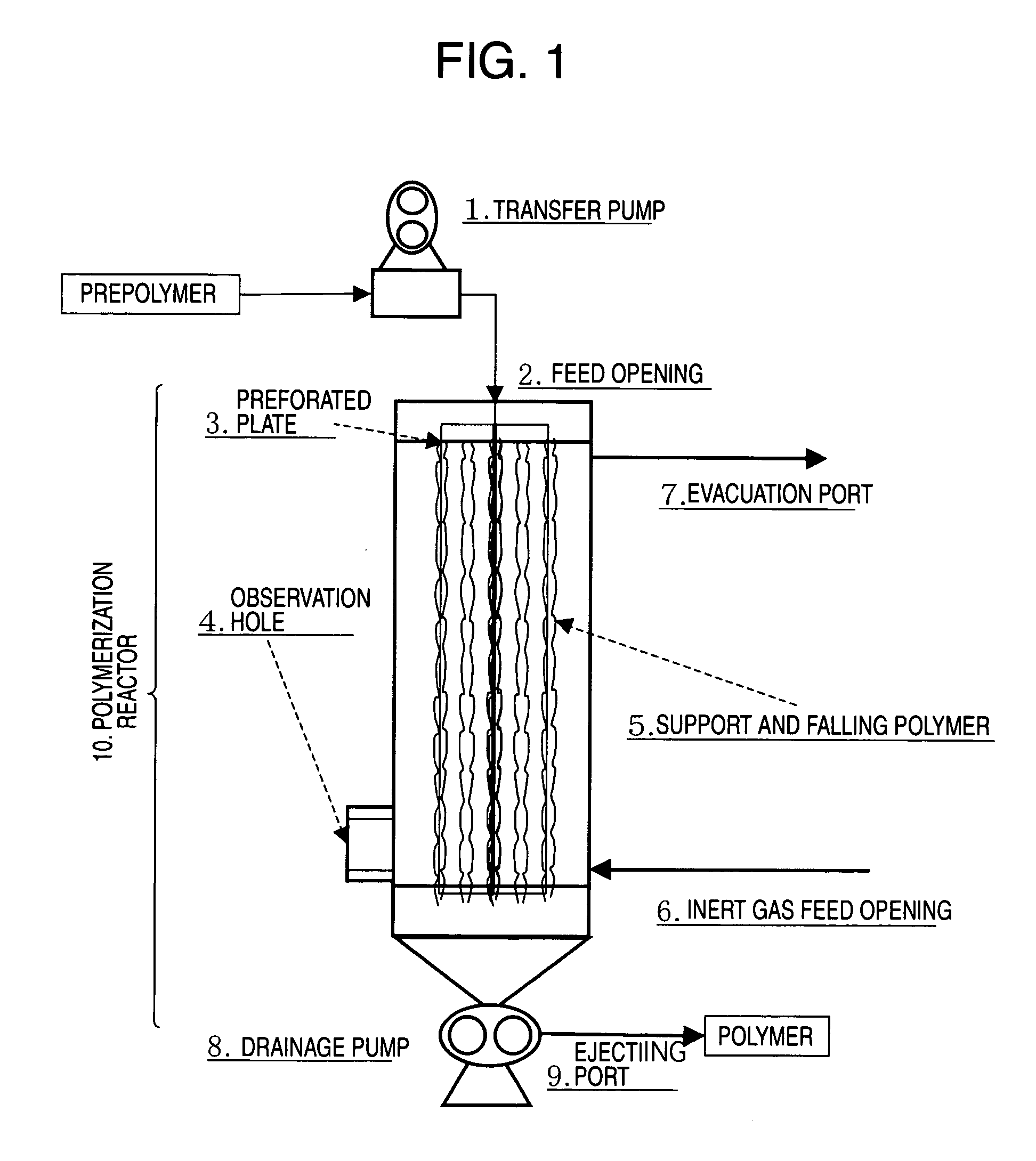Process for Producing Polyalkylene Terephthalate, Process for Producing Polyalkylene Terephthalate Molding and Polyalkylene Terephthalate Molding
- Summary
- Abstract
- Description
- Claims
- Application Information
AI Technical Summary
Benefits of technology
Problems solved by technology
Method used
Image
Examples
example 1
[0304]Using the apparatus shown in FIG. 1, a PET prepolymer having an intrinsic viscosity [η] of 0.45 dl / g, a carboxyl-terminal group concentration of 30 meq / kg, and a crystalline melting point of 260° C. was supplied through a feed opening 2 to a polymerization reactor 10 by a transfer pump 1. The PET prepolymer that was in a molten state at 280° C. was discharged from holes on a perforated plate 3 at an amount of 10 g / min. per hole. Thereafter, the prepolymer was polymerized under reduced pressure of 65 Pa, while it was allowed to fall along a support at the same ambient temperature as the discharge temperature of the prepolymer. The resultant product was then removed from an ejecting port 9 by a drainage pump 8, so as to obtain PET. The used perforated plate had a thickness of 50 mm, and had 4 holes thereon, each having a diameter of 1 mm, which were linearly aligned at an interval of 25 mm. As a support, a lattice-form support was used, wherein a wire having a diameter of 2 mm a...
examples 2 and 3
[0307]Polymerization was carried out in the same manner as in Example 1 with the exception that the conditions shown in Table 6 were applied. Polymerization conditions and the properties of the obtained resins are shown in Table 6. In both cases of Examples 2 and 3, intensive foaming of a prepolymer discharged from a perforated plate during polymerization and contamination of a nozzle surface and the like due to such intensive foaming were observed to an extremely small extent. The falling resin contained a large amount of bubbles. The obtained polymer had a high polymerization degree and a good color tone, containing a small amount of acetaldehyde. Thus, it was high-quality homogenous PET.
examples 4 to 6
[0313]A prepolymer was discharged from a perforated plate on which 4 holes were aligned in a lattice form at a rate of 23 g / min. per hole. Thus, polymerization was carried out in the same manner as in Example 1 with the exception that a support having a form described below was used. In Example 4, a space lattice-form support formed by combining wires with a diameter of 3 mm at an interval of 30 mm in the vertical direction and at an interval of 50 mm in the horizontal direction was used; in Example 5, a chain-form support obtained by connecting elliptical forms with a wire diameter of 3 mm, a length of 50 mm, and a curvature of 20 mmφ was used; and in Example 6, a wire-form support having a circular cross section with a diameter of 5 mm was used (which correspond to supports 2 to 4 described in Table 2, respectively). Polymerization conditions and the properties of the obtained resins are shown in Table 6. In all the cases, intensive foaming of a prepolymer discharged from a perfor...
PUM
| Property | Measurement | Unit |
|---|---|---|
| Temperature | aaaaa | aaaaa |
| Temperature | aaaaa | aaaaa |
| Fraction | aaaaa | aaaaa |
Abstract
Description
Claims
Application Information
 Login to View More
Login to View More - R&D
- Intellectual Property
- Life Sciences
- Materials
- Tech Scout
- Unparalleled Data Quality
- Higher Quality Content
- 60% Fewer Hallucinations
Browse by: Latest US Patents, China's latest patents, Technical Efficacy Thesaurus, Application Domain, Technology Topic, Popular Technical Reports.
© 2025 PatSnap. All rights reserved.Legal|Privacy policy|Modern Slavery Act Transparency Statement|Sitemap|About US| Contact US: help@patsnap.com



